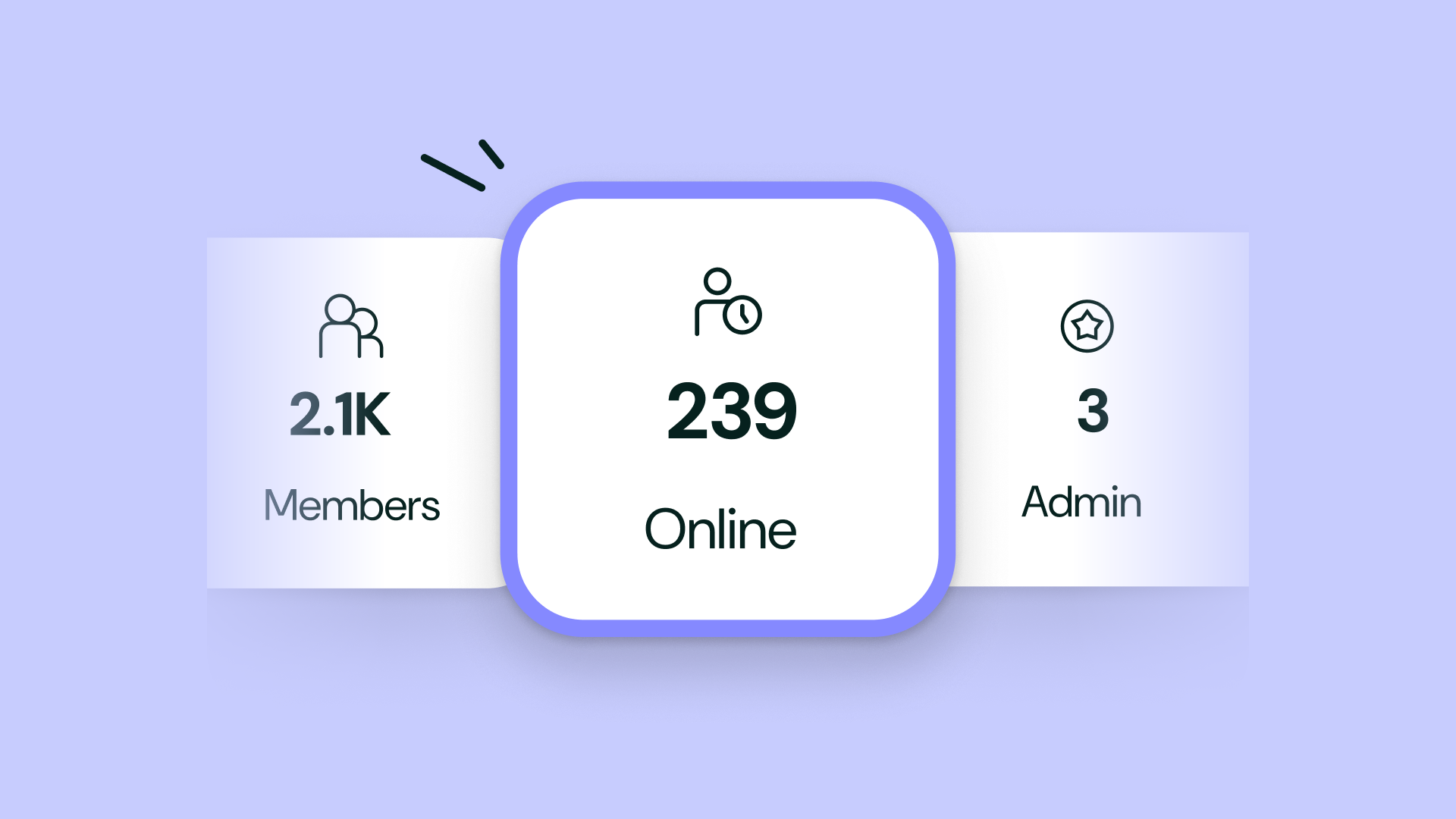How to Name Your Online Course: The Complete Guide to Titles That Convert (and Actually Get Found!)
 Membership.io Team
Membership.io Team
Jul 11, 2025
Let’s talk about something deceptively simple that can make or break your online course: the name.
It’s not just a label—it’s the front door to your business.
A great course name is like a well-lit, inviting entrance. It tells people they’re in the right place, and it draws them in. A bad name? It’s like a door with no sign, no handle, and no reason to stop. People scroll past without a second thought.
You can invest heavily in designing an online course, but if the name doesn’t catch attention, no one makes it inside to see what’s waiting.
In this article, you’ll learn how to name your course in a way that grabs interest, builds curiosity, and turns casual browsers into eager buyers.
Why Your Digital Course Name Is Your Secret Weapon (Seriously!)
Think about it: your course name shows up everywhere.
It’s in Google search results, course marketplaces, email subject lines, social media posts, and even word-of-mouth when someone recommends your course to a friend.
So, if your name is confusing, bland, or forgettable? You’re losing potential students before they even see what you’re offering.
A Great Course Name Should:
- Clearly communicate the topic – No guesswork. People should know instantly if it’s for them.
- Promise a transformation – People don’t buy content; they buy outcomes. Your name should hint at the result.
- Stand out – The market is crowded. Your name should catch attention and be easy to remember.
- Build trust – A polished name signals a polished product.
- Boost discoverability – A strategic, SEO-friendly name helps people find you.
You don’t need to hit all of these, but miss too many, and your course could collect digital dust. Nail it, and you’ve just opened the door to success.
Step 1: Know Your Ideal Student And Get Inside Their Head
Before brainstorming a single course name, you need to become a detective. Your mission? Understanding your ideal student so well that you know exactly what words will make them stop scrolling and think, "This is exactly what I need!"
Ask yourself these key questions:
- What keeps them up at night?
- What do they really want to achieve?
- How do they describe their problems?
- What grabs their attention instantly?
- Where do they spend time online?
Quick Tip: Don't guess. Go to where your audience hangs out and listen. Check out Facebook groups, Reddit threads, YouTube comments, and Instagram posts in your niche.
Take screenshots or copy and paste the exact words your audience uses when talking about their problems. Then, drop that text into an AI tool like ChatGPT or Claude and ask it to identify the top keywords, questions, and pain points.
This kind of research is a goldmine as it can shape not only your course name but your entire marketing strategy.
Here’s a simple example: Let's say you're creating a course on meal planning. Your research might find that busy moms aren't just looking for "meal planning". They're using other terms, like "quick healthy dinners," "meal prep for picky eaters," or "how to feed my family without losing my mind."
See the difference?
A generic name like "Fuel Your Family" might sound catchy to you, but "Meal Prep for Busy Moms: Plan a Week of Healthy Dinners in Under an Hour" speaks directly to their specific pain point and desired outcome.

Step 2: Master the Art of SEO-Friendly Course Names
Let’s get a little technical for a second, because this part really matters if you want people to find your course.
Search Engine Optimization (SEO) isn’t just for websites. It applies to your course name, too. After all, your course lives online.
If someone types “how to start a podcast” into Google, wouldn’t you want your course to show up? A well-optimized name helps make that happen.
Your SEO game plan:
Start with keyword researchvt using tools like:
- Google Autocomplete (just start typing in the search bar and see what comes up)
- Ubersuggest (free keyword research tool)
- AnswerThePublic (shows you questions people are asking)
- Even Pinterest search suggestions can be a great resource!
- Use ChatGPT and deep research to see what’s trending.
Need an SEO expert to follow? Matt Diamante at @heytony.agency is over on Instagram, which is an awesome resource!
- Look for the sweet spot. High search volume and manageable competition. You want keywords people are actually searching for, but not so competitive that you'll never rank.
- Place your main keyword early. "Instagram Growth Strategies" performs better than "Strategies for Growing Your Instagram" because the primary keyword appears first.
- Think long-tail keywords. Instead of targeting "photography" (way too broad and competitive), go for "smartphone photography for beginners" or "portrait photography lighting techniques."
Here’s a simple example: If you're teaching email marketing, instead of "Email Marketing Course," try "Email Marketing for Small Business: Build a List That Actually Converts." You're targeting "email marketing for small business" while also promising a specific outcome.
Step 3: Clarity Beats Cleverness Every Single Time
You want your course name to be creative and memorable, and that’s totally understandable. But here's the truth bomb (uh oh). If someone can't immediately understand what your course is about, your clever name just became a conversion killer.
The clarity test: Show your course name to someone who knows nothing about your business. If they can't tell you what the course is about within 5 seconds, it's too clever for its own good.
What to avoid:
- Inside jokes only you understand
- Metaphors that require explanation
- Brand puns that confuse more than clarify
- Made-up words that don't mean anything
- Acronyms that need to be explained (or sometimes mean something else…)
Examples of clarity in action:
❌Too clever: "The Phoenix Method"
✅Clear winner: "From Burnout to Breakthrough: Rebuild Your Life in 90 Days"
❌Too vague: "Digital Transformation Secrets"
✅Crystal clear: "Turn Your Skills Into Profitable Online Courses: A Step-by-Step Blueprint"
Remember, you can always get creative with your course branding, colors, and imagery. But your name needs to do the heavy lifting of communication first.
Step 4: Show and Promise the Transformation (Not the Stuff)
Here's a marketing truth that never gets old: people don't buy courses and content… They buy transformations. They buy the person they'll become, the problem they'll solve, or the skill they'll master.
And the icing on the cake? Speed, convenience, and ease.
Your course name should paint a picture of their "after" state. What will be different in their life once they complete your course?
Digital course transformation frameworks that work:
- "How to [Achieve Desired Outcome]"
- "How to Build a Profitable Blog from Scratch"
- "How to Speak Confidently in Any Situation"
- "[Number] Steps to [Specific Result]"
- "7 Steps to Your First $10K Month"
- "5 Steps to Perfect Wedding Photography"
- "[Achieve Goal] Without [Common Pain Point]"
- "Build Tricep Muscle Without Spending Hours in the Gym"
- "Launch Your Digital Business Without Quitting Your Day Job"
- "From [Current State] to [Desired State]"
- "From Side Hustle to Six Figures"
- "From Camera Shy to Confident on Video"
The key is specificity. "Make Money Online" is vague and overdone. "Build a $5K/Month Virtual Assistant Business in 6 Months" is specific, believable, and compelling.
Step 5: Harness the Power of Power Words
Power words are emotionally charged terms that grab attention and make your course instantly more appealing. They create urgency, build authority, spark curiosity, or highlight ease, helping your course name stand out and convert more effectively.
When used strategically, powerful words can dramatically increase the impact of your course title.
Categories of power words that work:
- Authority builders: Expert, Proven, Certified, Professional, Mastery, Advanced
- Speed indicators: Quick, Fast, Rapid, Instant, Accelerated, Express
- Completeness signals: Ultimate, Complete, Comprehensive, Total, Full
- Curiosity creators: Secret, Hidden, Behind-the-Scenes, Insider, Exclusive
- Beginner-friendly: Beginner, Simple, Easy, Step-by-Step, Foolproof
Before and after examples:
❌ Bland: "Photography Basics"
✅ Powerful: "The Complete Beginner's Guide to Stunning Photography"
❌ Boring: "Social Media Marketing"
✅ Compelling: "Social Media Mastery: Proven Strategies to Grow Your Following Fast"
Quick Tip: Don't go overboard! One or two well-placed power words are more effective than cramming five into your title. You want to sound credible, not like a late-night infomercial.

Step 6: Keep It Short, Sweet, and Memorable
In our scroll-happy world, attention spans are shorter than ever. So, your course name needs to be:
- Scannable. People should be able to read and understand it in 3 seconds or less.
- Memorable. It should stick in their mind long after they've seen it.
- Shareable: Easy to remember and repeat to friends
- The magic number: Aim for under 65 characters for your main title. This ensures it won't get cut off in search results, email subject lines, or mobile views.
Clarity is key. So if you need more space, use a subtitle structure.
Main Title: "Course Creator Kickstart"
Subtitle: "Launch Your First Profitable Online Course in 30 Days Without Tech Overwhelm"
Quick Tip. Use the soundcheck test. Say your course name out loud. Does it roll off the tongue? Would someone easily remember it after hearing it once? If you stumble over it or it feels awkward, it's probably too complex.
Step 7: Use Proven Naming Frameworks (Your Creative Shortcuts!)
When you're staring at a blank screen wondering where to start, these tried-and-tested frameworks can jumpstart your creativity.
Staring at a blank screen, unsure where to start? These proven name frameworks can help you break through the block and craft a compelling title fast.
1. The “Like a Boss” Framework
Structure: [Skill/Outcome] Like a Boss: The Complete Guide to [Specific Outcome]
Examples:
- Cook Like a Boss: The Complete Guide to Weeknight Dinners That Wow
- Declutter Like a Boss: The New Way Busy Parents Keep the House Clean and Organized
2. The Timeframe Promise
Structure: How to [Achieve X] in [Timeframe] or Less
Examples:
- How to Build Your Email List to 1,000 Subscribers in 30 Days
- How to Master Calligraphy in Just 2 Weeks
3. The Fastest & Easiest Way
Structure: [Course Name]: The Fastest & Easiest Way to [Outcome]
Examples:
- Podcast Launch Academy: The Fastest & Easiest Way to Start Your Show
- SEO Simplified: The Fastest & Easiest Way to Rank on Google
4. The Niche + Product Type
Structure: [Target Audience] + [Course Type]
Examples:
- Busy Mom Entrepreneur Accelerator
- Beginner Watercolor Artist Masterclass
5. The Problem-to-Solution Journey
Structure: From [Problem/Current State] to [Solution/Desired State]
Examples:
- From Cluttered to Calm: Organize Your Home and Life
- From Broke to Booked: Fill Your Coaching Calendar

Step 8: The Ultimate Course Name Test
Before you lock in your course name, make sure it actually works. A name that sounds great to you might fall flat with your audience. Testing helps you catch confusion, weak messaging, or missed opportunities so you can launch with confidence, not guesswork.
Here's how to test it properly:
The Clarity Check
- Can someone immediately tell what this course is about?
- Would a complete stranger understand who it's for?
- Is the benefit or outcome crystal clear?
The Conversion Check
- Does it promise a specific, desirable result?
- Would your ideal student be excited about this outcome?
- Does it address a real pain point or desire?
The Competition Check
- How does it stand out from similar courses?
- Is it unique enough to be memorable?
- Does it position you differently in the market?
The SEO Check
- Does it include keywords your audience searches for?
- Will it perform well in search results?
- Is it discoverable on course platforms?
The Real-World Test
- Here's where the rubber meets the road: test your top 2-3 name options with real people from your target audience.
How to test:
- Create a simple poll on your social media
- Ask your email list to vote on their favorite
- Run a quick survey in relevant Facebook groups
- Ask friends who fit your target demographic
What to ask:
- Which title makes you most curious to learn more?
- Which one clearly communicates what you'd learn?
- Which would you be most likely to click on?
Don't just ask which one they "like" best. Focus on which one would drive action.
Step 9: Leverage AI and Online Tools (When You're Really Stuck)
Sometimes you're staring at the screen, juggling half-formed ideas and second-guessing every name you come up with. Nothing feels quite right, and the harder you try, the more stuck you feel. When you're in that creative fog, a little outside inspiration can go a long way.
Here are some tools to help spark fresh ideas:
ChatGPT
Best for: Custom, conversational brainstorming
Strengths:
- Extremely flexible and creative
- Let's you provide detailed context (topic, audience, goals)
- Can explore multiple directions and iterate quickly
Jasper AI
Best for: Fast, structured suggestions with minimal input
Strengths:
- Includes dedicated templates for course naming
- Focuses on marketing language and conversion
- Ideal for quick, polished results
Copy.ai
Best for: Quick idea generation at scale
Strengths:
- Offers a specific Course Title Generator tool
- Generates a wide variety of names instantly
- Useful for sparking inspiration through volume
Benefit: Copy.ai is great when you need lots of options to sort through. It’s especially helpful for breaking creative blocks and spotting patterns in naming styles.
Quick Tip: These tools won't give you the perfect name ready-made, but they're excellent for sparking ideas you might not have considered. Use them as starting points, not final solutions.
Advanced Course Naming Strategies for Maximum Impact
The Series Strategy
If you're planning multiple courses, consider creating a recognizable series:
"The Entrepreneur's Toolkit: Course 1 - Business Foundations"
"The Entrepreneur's Toolkit: Course 2 - Marketing Mastery"
"The Entrepreneur's Toolkit: Course 3 - Sales Systems"
The Level-Based System
Perfect for skills-based courses:
"Photography Fundamentals: Master Your Camera Settings"
"Photography Pro: Advanced Lighting Techniques"
"Photography Business: Turn Your Passion Into Profit"
The Outcome-Focused Approach
Lead with the end result:
"The $100K Freelancer: Build a Six-Figure Writing Business"
"The Confident Speaker: Overcome Stage Fright and Command Any Room"
"The Organized Life: Create Systems That Actually Stick"
Common Course Naming Mistakes (And How to Avoid Them)
Mistake #1: Making it about you instead of them
❌ "Sarah's Photography Methods"
✅ "Master Portrait Photography: Create Stunning Photos Every Time"
Mistake #2: Being too broad or generic
❌ "Business Success Course"
✅ "Launch Your Consulting Business: From Idea to First Client in 60 Days"
Mistake #3: Using industry jargon or complicated terms
❌ "Optimize Your Sales Funnel Conversion Metrics"
✅ "Turn More Website Visitors Into Paying Customers"
Mistake #4: Focusing on features instead of benefits
❌ "10 Hours of Video Content on Email Marketing"
✅ "Build an Email List That Sells: Grow Your Audience and Revenue"
Mistake #5: Making promises you can't keep
❌ "Become a Millionaire in 30 Days"
✅ "Build Multiple Income Streams: Start Your Path to Financial Freedom"
Your Course Naming Action Plan
Ready to name your course like a pro? Here's your step-by-step action plan:
Week 1: Research Phase
- Survey your target audience about their biggest challenges or pain points
- Research keywords using free tools like Ubersuggest
- Analyze competitor course names in your niche
- Collect language and phrases your audience uses
Week 2: Creation Phase
- Use the frameworks to generate 10-15 potential names
- Apply the clarity and conversion tests
- Check each name for SEO potential
- Narrow down to your top 5 favorites
Week 3: Testing Phase
- Test your top 3 names with your audience
- Get feedback from people who fit your target demographic
- Check domain availability if you plan to create a website
- Ensure the name works across all platforms you'll use
Week 4: Decision Phase
- Analyze test results and feedback
- Make your final decision
- Secure social handles and domains if needed
- Start using your new course name in marketing materials
Final Thoughts: Don't Let Perfect Be the Enemy of Getting Started
Here's the honest truth. There's no such thing as a perfect course name. What matters is that your name clearly communicates value, speaks to your audience, and feels authentic to you and your brand.
The most important thing? Don't let the naming process stop you in your tracks. It’s better to get it going than get it right.
We've seen too many brilliant course creators spend months agonizing over the perfect name while their amazing content sits unpublished.
Use the strategies in this guide to create a strong, clear, compelling course name. Then get back to what really matters: creating incredible content that transforms your students' lives.
Your course name is important, but it's just the beginning. The real magic happens when someone clicks "enroll" and starts their transformation journey with you.
In conclusion, a good course name that gets your content out into the world is infinitely better than a perfect name that never sees the light of day. Name it, launch it, and iterate as you grow.
Now stop overthinking and start creating! Your future students are waiting for the transformation only you can provide.
Ready to start your digital course? Get started with Membership.io today!





